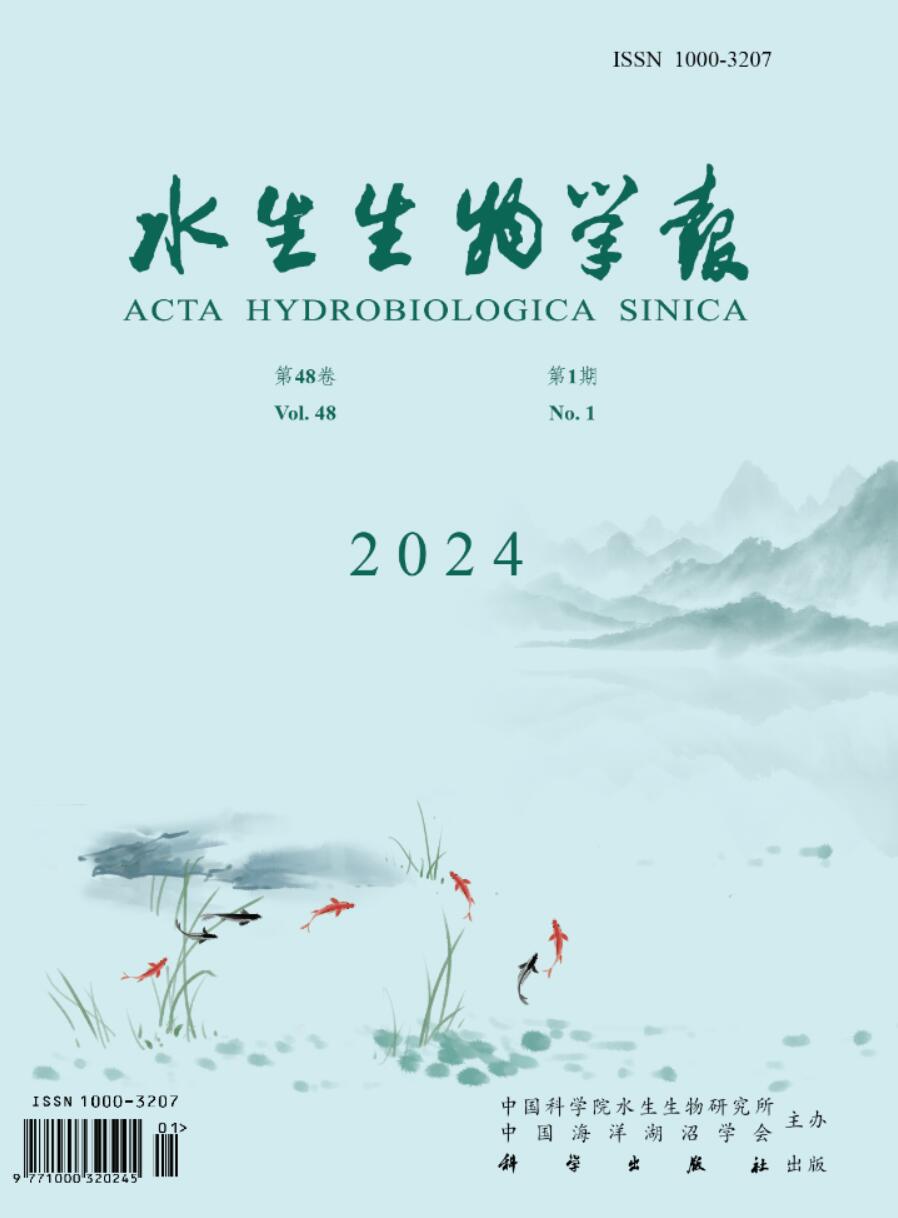EFFECT OF ACUTE SALINITY STRESS ON SOLUBLE PROTEIN,HEMOCYANIN,HAEMOLYMPH GLUCOSE AND HEPATOPANCREAS GLYCOGEN OF ERIOCHEIR SINENSIS
引用次数: 5
Abstract
Most of the decapod species of crustacean have comprehensive capacity of osmoregulation,and they can adapt to relative wide ambient salinity range.It is important to understand the underlying mechanisms of their comprehensive adaptability to salinity change because this knowledge is helpful for inland culturing of marine species.As a euryhaline crustacean,the Chinese mitten crab,Eriocheir sinensis,has been well studied in many aspects related to their physiological responses to salinity change,and many useful literature findings have been accumulated.Therefore,E.sinensis can be considered as an animal model for studying osmoregulation mechanism of the decapod species.However,the roles of nutrients in osmoregulation of E.sinensis are still limited.In this paper,male E.sinensis in freshwater(0.3‰) were transferred directly into waters at salinity values of 16‰ and 30‰,respectively,and the crabs kept at fresh water served as the control.Each treatment has three replicates.The soluble protein in haemolymph and hepatopancreas,hemocyanin,haemolymph glucose and hepatopancreas glycogen at 0h,6h,12h,24h,48h,72h and 96h of E.sinensis at different salinities were determined.Soluble protein of haemolymph and hepatopancreas were measured with a Folin reagent based on a standard curve using bovine serum albumin as the standard protein.Hemocyanin was assayed using an ultraviolet absorption methods at 335 nm and calculated according to Nickerson 1% 1cm E =2.83.Haemolymph glucose was assayed using glucose oxidase-peroxide enzyme(GOD-POD) method.Hepatopancreas glycogen was measured using the anthrone colorimetry method.The results showed that the crabs at salinity 16‰ and 30‰ had significantly lower soluble protein content of hepatopancreas than those at fresh water(P0.05) when crabs had encountered salt water for 12h—96h,and the soluble protein content of haemolymph decreased significantly from 6h to 48h,and then increased at 72h.The hemocyanin content showed a significantly decreasing trend from 0h to 24h,and then it increased after 48h.Hepatopancreas glycogen contents at salinity 16‰ and 30‰ were significantly lower than those at fresh water(P0.05) from 6h to 96h,while no significant differences were observed between crabs in waters with salinity 16‰ and 30‰(P0.05).Haemolymph glucose content at 16‰ reduced significantly(P0.05) from 24h to 48h,and gradually recovered up at 72h,but it showed a significantly decreasing trend from 6h to 12h at salinity 30‰,and then gradually increased after 24h.All these results indicated that E.sinensis could produce physiological and biochemical adaptation to maintain a stable osmotic pressure during acute salinity stress.Carbohydrate and protein play important roles in the osmoregulation of crustaceans.E.sinensis could use carbohydrate first to provide energy under acute salinity stress.The higher the salinity,the faster the haemolymph glucose was consumed,and it also recovered more quickly.This observation suggested that carbohydrate could be a direct source in osmoregulation.The crabs may use protein to maintain the balance of osmotic pressure under high salinity by metabolizing the protein into free amino acids.Beside providing free amino acids,hemocyanin also can carry oxygen to meet the needs for physiological activities.Therefore,more attention should be paid to carbohydrate and protein supplied under salinity stress.The ratio of free amino acids maintaining the balance of osmotic pressure and supplying energy by oxidation and the utilization of lipid in osmoregulation require further study.Since the lipid contents in haemolymph and hepatopancreas were not determined in this study,the role of body lipid in E.sinensis was not discussed here and should be further examined.急性盐胁迫对中华绒螯蟹可溶性蛋白、血青素、血淋巴葡萄糖和肝胰脏糖原的影响
大多数甲壳类十足动物具有全面的渗透调节能力,能适应较宽的环境盐度范围。了解它们对盐度变化的综合适应性的潜在机制是重要的,因为这有助于海洋物种的内陆养殖。中华绒螯蟹(Eriocheir sinensis)作为一种全盐性甲壳类动物,对其盐度变化的生理反应进行了多方面的研究,并积累了许多有益的文献发现。中华鲟可作为研究十足动物渗透调节机制的动物模型。然而,营养物质在紫菜渗透调节中的作用仍然有限。本文将淡水(0.3‰)中雄性中华赤潮蟹直接转移到盐度为16‰和30‰的水体中,以淡水中的蟹为对照。每个处理有三个重复。测定不同盐度下中华绒螯蟹0h、6h、12h、24h、48h、72h和96h血淋巴和肝胰脏可溶性蛋白、血青素、血淋巴葡萄糖和肝胰脏糖原的含量。以牛血清白蛋白为标准蛋白,用福林试剂按标准曲线测定血淋巴和肝胰脏的可溶性蛋白。采用335 nm紫外吸收法测定血青素,按Nickerson 1% 1cm E =2.83计算。采用葡萄糖氧化酶-过氧化物酶(GOD-POD)法测定血淋巴葡萄糖。采用蒽酮比色法测定肝胰脏糖原。结果表明:盐度为16‰和30‰的蟹在盐度为12 ~ 96h时,肝胰脏可溶性蛋白含量显著低于淡水环境(P0.05),血淋巴可溶性蛋白含量从6 ~ 48h显著降低,在72h时又显著升高。血青素含量在0h ~ 24h呈显著下降趋势,48h后呈上升趋势。6 ~ 96h,盐度为16‰和30‰的蟹肝胰脏糖原含量显著低于淡水(P0.05),而盐度为16‰和30‰的蟹肝胰脏糖原含量差异不显著(P0.05)。16‰时24 ~ 48h血淋巴葡萄糖含量显著降低(P0.05), 72h时逐渐回升,30‰时6 ~ 12h血淋巴葡萄糖含量呈显著下降趋势,24h后逐渐升高。上述结果表明,在急性盐度胁迫下,中华沙棘能够产生生理生化适应以维持稳定的渗透压。碳水化合物和蛋白质在甲壳类动物的渗透调节中起着重要的作用,在急性盐胁迫下,中华赤霉素可以首先利用碳水化合物提供能量。盐度越高,血淋巴葡萄糖消耗得越快,恢复得也越快。这一观察结果表明,碳水化合物可能是渗透调节的直接来源。在高盐度条件下,蟹可利用蛋白质代谢成游离氨基酸,维持渗透压平衡。血青素除了提供游离氨基酸外,还能携带氧气以满足生理活动的需要。因此,应重视盐胁迫下碳水化合物和蛋白质的供应。维持渗透压平衡并通过氧化提供能量的游离氨基酸比例以及脂质在渗透调节中的利用有待进一步研究。由于本研究未测定血淋巴和肝胰脏的脂质含量,因此本文未讨论体脂在中华赤霉素中的作用,有待进一步研究。
本文章由计算机程序翻译,如有差异,请以英文原文为准。
求助全文
约1分钟内获得全文
求助全文

 求助内容:
求助内容: 应助结果提醒方式:
应助结果提醒方式:


